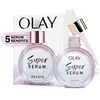What's inside
What's inside
 Key Ingredients
Key Ingredients

 Benefits
Benefits

 Concerns
Concerns

 Ingredients Side-by-side
Ingredients Side-by-side

Water
Skin ConditioningGlycerin
HumectantDimethicone
EmollientNiacinamide
SmoothingLactic Acid
BufferingPolyacrylate Crosspolymer-6
Emulsion StabilisingPalmitoyl Pentapeptide-4
Skin Conditioning3-O-Ethyl Ascorbic Acid
Skin ConditioningSodium Hyaluronate
HumectantTocopheryl Acetate
AntioxidantPanthenol
Skin ConditioningTrehalose
HumectantPEG-11 Methyl Ether Dimethicone
EmulsifyingSodium Lactate
BufferingMica
Cosmetic ColorantTitanium Dioxide
Cosmetic ColorantSodium Benzoate
MaskingParfum
MaskingWater
Skin ConditioningNannochloropsis Oculata Extract
HumectantPullulan
Acetyl Hexapeptide-8
HumectantAcmella Oleracea Extract
Skin ProtectingAllantoin
Skin ConditioningEuterpe Oleracea Fruit Extract
Epilobium Angustifolium Flower/Leaf/Stem Extract
Skin ConditioningGlycerin
HumectantAscorbic Acid
AntioxidantPseudoalteromonas Ferment Extract
HumectantHydrolyzed Wheat Protein
Skin ConditioningHydrolyzed Soy Protein
HumectantTripeptide-10 Citrulline
Skin ConditioningTripeptide-1
Skin ConditioningLecithin
EmollientButylene Glycol
HumectantXanthan Gum
EmulsifyingCarbomer
Emulsion StabilisingTriethanolamine
BufferingCaprylyl Glycol
EmollientDimethicone
EmollientCetyl Alcohol
EmollientSodium Acrylate/Sodium Acryloyldimethyl Taurate Copolymer
Emulsion StabilisingGlyceryl Stearate
EmollientCaprylic/Capric Triglyceride
MaskingAcrylamide/Sodium Acrylate Copolymer
Paraffinum Liquidum
EmollientTrideceth-6
EmulsifyingPropylene Glycol
HumectantDiazolidinyl Urea
PreservativeIodopropynyl Butylcarbamate
PreservativeTetrasodium EDTA
Phenoxyethanol
PreservativeSodium Benzoate
MaskingAlcohol
AntimicrobialPotassium Sorbate
PreservativeWater, Nannochloropsis Oculata Extract, Pullulan, Acetyl Hexapeptide-8, Acmella Oleracea Extract, Allantoin, Euterpe Oleracea Fruit Extract, Epilobium Angustifolium Flower/Leaf/Stem Extract, Glycerin, Ascorbic Acid, Pseudoalteromonas Ferment Extract, Hydrolyzed Wheat Protein, Hydrolyzed Soy Protein, Tripeptide-10 Citrulline, Tripeptide-1, Lecithin, Butylene Glycol, Xanthan Gum, Carbomer, Triethanolamine, Caprylyl Glycol, Dimethicone, Cetyl Alcohol, Sodium Acrylate/Sodium Acryloyldimethyl Taurate Copolymer, Glyceryl Stearate, Caprylic/Capric Triglyceride, Acrylamide/Sodium Acrylate Copolymer, Paraffinum Liquidum, Trideceth-6, Propylene Glycol, Diazolidinyl Urea, Iodopropynyl Butylcarbamate, Tetrasodium EDTA, Phenoxyethanol, Sodium Benzoate, Alcohol, Potassium Sorbate
 Reviews
Reviews

Ingredients Explained
These ingredients are found in both products.
Ingredients higher up in an ingredient list are typically present in a larger amount.
Dimethicone is a type of synthetic silicone created from natural materials such as quartz.
What it does:
Dimethicone comes in different viscosities:
Depending on the viscosity, dimethicone has different properties.
Ingredients lists don't always show which type is used, so we recommend reaching out to the brand if you have questions about the viscosity.
This ingredient is unlikely to cause irritation because it does not get absorbed into skin. However, people with silicone allergies should be careful about using this ingredient.
Note: Dimethicone may contribute to pilling. This is because it is not oil or water soluble, so pilling may occur when layered with products. When mixed with heavy oils in a formula, the outcome is also quite greasy.
Learn more about DimethiconeGlycerin is already naturally found in your skin. It helps moisturize and protect your skin.
A study from 2016 found glycerin to be more effective as a humectant than AHAs and hyaluronic acid.
As a humectant, it helps the skin stay hydrated by pulling moisture to your skin. The low molecular weight of glycerin allows it to pull moisture into the deeper layers of your skin.
Hydrated skin improves your skin barrier; Your skin barrier helps protect against irritants and bacteria.
Glycerin has also been found to have antimicrobial and antiviral properties. Due to these properties, glycerin is often used in wound and burn treatments.
In cosmetics, glycerin is usually derived from plants such as soybean or palm. However, it can also be sourced from animals, such as tallow or animal fat.
This ingredient is organic, colorless, odorless, and non-toxic.
Glycerin is the name for this ingredient in American English. British English uses Glycerol/Glycerine.
Learn more about GlycerinSodium Benzoate is a preservative. It's used in both cosmetic and food products to inhibit the growth of mold and bacteria. It is typically produced synthetically.
Both the US FDA and EU Health Committee have approved the use of sodium benzoate. In the US, levels of 0.1% (of the total product) are allowed.
Sodium benzoate works as a preservative by inhibiting the growth of bacteria inside of cells. It prevents the cell from fermenting a type of sugar using an enzyme called phosphofructokinase.
It is the salt of benzoic acid. Foods containing sodium benzoate include soda, salad dressings, condiments, fruit juices, wines, and snack foods.
Studies for using ascorbic acid and sodium benzoate in cosmetics are lacking, especially in skincare routines with multiple steps.
We always recommend speaking with a professional, such as a dermatologist, if you have any concerns.
Learn more about Sodium BenzoateWater. It's the most common cosmetic ingredient of all. You'll usually see it at the top of ingredient lists, meaning that it makes up the largest part of the product.
So why is it so popular? Water most often acts as a solvent - this means that it helps dissolve other ingredients into the formulation.
You'll also recognize water as that liquid we all need to stay alive. If you see this, drink a glass of water. Stay hydrated!
Learn more about Water